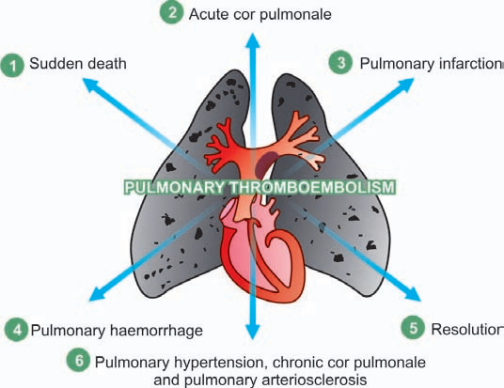
Embolism
EMBOLISM
Definition and Types
Embolism is the process of partial or complete obstruction of
some part of the cardiovascular system by any mass carried
in the circulation; the transported intravascular mass
detached from its site of origin is called an embolus. Most
usual forms of emboli (90%) are thromboemboli i.e.
originating from thrombi or their parts detached from the
vessel wall.
Emboli may be of various types:
A. Depending upon the matter in the emboli:
i) Solid e.g. detached thrombi (thromboemboli), atheromatous
material, tumour cell clumps, tissue fragments,
parasites, bacterial clumps, foreign bodies.
ii) Liquid e.g. fat globules, amniotic fluid, bone marrow.
iii) Gaseous e.g. air, other gases.
B. Depending upon whether infected or not:
i) Bland, when sterile.
ii) Septic, when infected.
C. Depending upon the source of the emboli:
i) Cardiac emboli from left side of the heart e.g. emboli
originating from atrium and atrial appendages, infarct in the
left ventricle, vegetations of endocarditis.
ii) Arterial emboli e.g. in systemic arteries in the brain, spleen,
kidney, intestine.
iii) Venous emboli e.g. in pulmonary arteries.
iv) Lymphatic emboli can also occur.
D. Depending upon the flow of blood, two special types
of emboli are mentioned:
i) Paradoxical embolus. An embolus which is carried from
the venous side of circulation to the arterial side or vice versa
is called paradoxical or crossed embolus e.g. through
arteriovenous communication such as in patent foramen
ovale, septal defect of the heart, and arteriovenous shunts in
the lungs.
ii) Retrograde embolus. An embolus which travels against the
flow of blood is called retrograde embolus e.g. metastatic
deposits in the spine from carcinoma prostate. The spread
occurs by retrograde embolism through intraspinal veins
which carry tumour emboli from large thoracic and
abdominal veins d,ue to increased pressure in body cavities
e.g. during coughing or straining.


You must log in to post a comment.